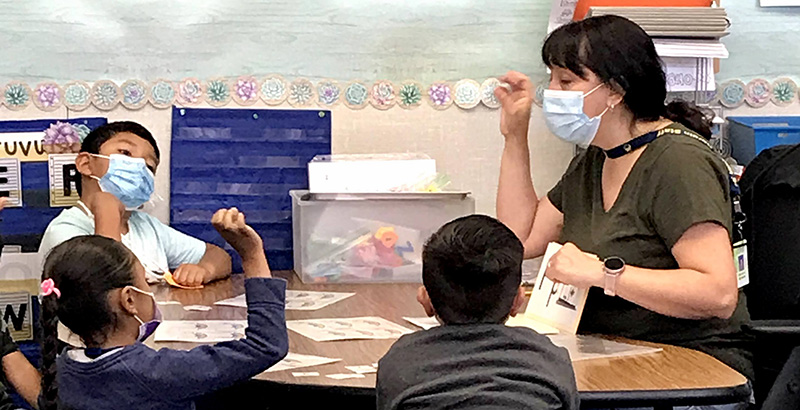Amid Literacy Crisis, CA Ed Chief Rejects Phonics-Driven Approach to Reading
With emphasis on library cards and free books, Tony Thurmond’s plan is drawing fire for offering ‘patchwork solutions to a system that never worked’

Get stories like these delivered straight to your inbox. Sign up for The 74 Newsletter
California Superintendent Tony Thurmond issued a challenge to the state’s school districts last week to ensure third graders become strong readers by 2026.
“We’re asking you to take a pledge today,” he said during the May 20 Zoom session, providing a link for participants to sign. Other elements of Thurmond’s agenda include library cards for 100,000 children, free access for families to ebooks and a campaign to deliver 1 million books to children’s homes.
The event followed the work of a literacy task force Thurmond created last fall. But the superintendent, who is running for reelection, was clear that as long as he’s in charge, California won’t follow the lead of other states — adopting a statewide literacy policy that prioritizes phonics, the connections between letter sounds and written words.
“We are not promoting a one-size-fits-all approach in California,” he said. “That’s been tried before. Our state is too large, is too diverse.”
Critics dismissed Thurmond’s plan to combat what they describe as a literacy crisis in the nation’s most populous state.
District leaders, advocates and some lawmakers want all schools to screen for dyslexia, a learning disability, and adopt phonics-based instruction. While New York City Mayor Eric Adams has mandated a phonics-based curriculum and Michigan lawmakers are pushing legislation that would require dyslexia screening, California, some argue, passed up an opportunity to address long-standing achievement gaps in children’s reading.
Overall, 37 percent of the state’s fourth-graders score below the basic level on federal reading tests. The average score for Hispanic students is 27 points below that of white students, and the gap between Black and white students is even larger.
“We keep applying patchwork solutions to a system that never worked,” said Todd Collins, a school board member of the Palo Alto Unified School District in Silicon Valley. He’s also an organizer of the California Reading Coalition, which last year issued a “report card” ranking districts on the percentage of high-need Hispanic students proficient in reading by third grade. “Library cards and e-books are not going to fix a system that doesn’t teach kids right in the first place.”
Some members of Thurmond’s literacy task force agree. Kareem Weaver, part of the Oakland NAACP’s education committee and leader of a nonprofit focusing on literacy, said the group produced “a grab bag” of solutions.
But they “didn’t get to the root cause of why kids aren’t reading,” he said. “We’re not explicitly teaching them how to read and crack the code.”
Thurmond isn’t opposed to districts adopting phonics-based instruction but instead emphasized that because of relief funds and a budget surplus “California has more resources than we’ve ever seen” to provide teacher training and increase the number of reading specialists in schools. Legislation passed last year requires new teachers entering the field to know how to teach “foundational reading skills,” but the state isn’t pushing districts to adopt a specific curriculum.
During Thurmond’s online event, only Tyrone Howard, an education professor at the University of California Los Angeles and president-elect of the American Educational Research Association, emphasized phonics.
“I’m old school,” he said. “The data shows that phonics instruction can go a long way in helping kids to develop the fundamentals around reading.”
Roughly 20 states have adopted so-called “science of reading” laws based on decades of research that emphasize phonics, fluency and vocabulary development as the foundations of learning how to read. Some experts who previously embraced strategies that encouraged children to depend on pictures and familiar words to read ones they don’t know have since changed their views. Once an exemplar of this approach, Lucy Calkins updated her curriculum based on the research, according to a recent New York Times article that generated a spirited reaction.
The question in California is whether a commitment is enough.
“We’ve been committing since ‘A Nation at Risk’ and we haven’t gotten there yet,” said Barbara Nemko, superintendent of the Napa County Office of Education, referring to the landmark 1983 report that inspired education reform efforts. One of Thurmond’s task force co-chairs, she added that if the label “science of reading” has become divisive, “then call it something else.”
Policymakers and education groups in the state are also divided over dyslexia screening, even though over 30 states already have such laws in place.
Thurmond promised to make a literacy screener currently in development at the University of California San Francisco available to schools once it’s ready, possibly by the 2023-24 school year. But the California Teachers Association opposes a dyslexia screening bill that was introduced last year and never received a hearing. They said mandated screening “lessens the instructional time available for learning the required curriculum.” The California School Boards Association also opposes it.
Reading Recovery and Mississippi
Thurmond isn’t the only state leader whose response to what some have called a literacy crisis has come under fire. Some question the support of researcher and state board Chair Linda Darling-Hammond for Reading Recovery, a long-running tutoring program for first graders offered in about 3,000 schools. In a 2010 book, state testimony on pandemic recovery and a recent literacy task force hearing, Darling-Hammond linked the program to successful schools.
A recent study, presented at a research conference, found that children who participated in the program scored lower on state tests in third and fourth grade than those who didn’t participate. Her comments, said Collins from Palo Alto, show “we have a dated and misguided understanding of what works.”
But Darling-Hammond, who also led President Joe Biden’s education transition team and recommended Miguel Cardona to be U.S. education secretary, told The 74 that her statements about the program have never been in the “context of an endorsement” and noted that Reading Recovery is listed in the U.S. Department of Education’s “clearinghouse” of recommended programs.
She underscored the limitations of the study, including the fact that the researchers collected follow-up results from just a quarter of the third graders and 16% of fourth graders who were part of the original sample. She noted that a separate study on Reading Recovery, presented at the same conference, found positive results for students in England through age 16.
“I think different interventions work well for different students,” Darling-Hammond said “I hope we won’t get wrapped up in a silver bullet idea about any intervention.”
She said California fourth graders’ reading scores have inched closer to the national average since 2013 and highlighted the state’s plan this year to spend $500 billion on literacy initiatives, including reading coaches and specialists. Those positions are necessary, she said, because the state hires too many teachers without full credentials.
“In the schools with the greatest needs, you might have half or more of the teachers without any training to teach reading,” she said.
She also pointed to gains in Mississippi, which in 2019, made more progress in reading than any other state. But she said people often “simplify” the state’s approach by only highlighting teacher training in phonics-based instruction.
“It’s a very robust program,” she said. “Phonics is very important. Phonemic awareness is very important, but that is not all they do.”
‘An equity issue’
With the state taking what Darling-Hammond called a more “decentralized” direction than Mississippi, some school and district leaders have moved on their own to revamp the way they teach children to read.
In 2019, when Lilia Espinoza took over as principal of Hardin Elementary in Hollister, California, she found staff members who worked hard on student reading with little to show for it.
“Historically, this school has struggled to really pump out students who are on grade level,” she said. With a high English learner population — as is the case in many California schools — she said teachers thought if children couldn’t read a word, they just didn’t understand the vocabulary instead of not being able to sound it out.
She reached out to Chartwell, a private school in Seaside, California, that offered training in structured literacy and using practices that have worked with struggling readers.
Hardin teachers and reading specialists now devote 45 minutes to an hour each day to explicit phonics lessons as part of a larger English language arts curriculum. Children can get “antsy” during that time, Espinoza said. But despite remote learning, the number of students referred to special education has dropped from 21 in 2017-19 to three this year. She thinks the gains would have been stronger if it hadn’t been for the pandemic.
Now, she worries that other “budget issues” will lead the district to cut funding for reading intervention teachers. She started with four, is now down to two, and might only have one next year. She wrote a letter to state leaders asking for more specialists.
“It’s an equity issue,” she said. “Not being able to secure support for early literacy for all students is not OK.”
Get stories like these delivered straight to your inbox. Sign up for The 74 Newsletter


